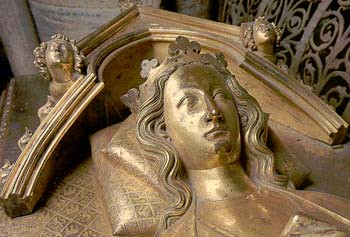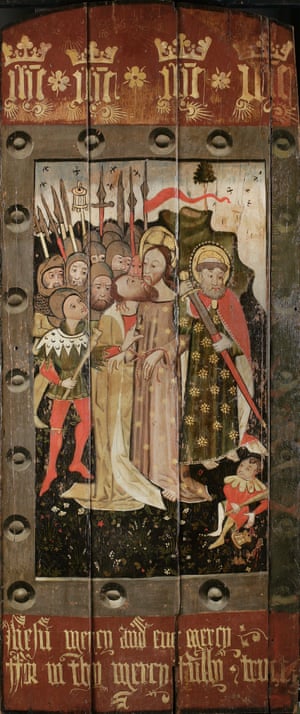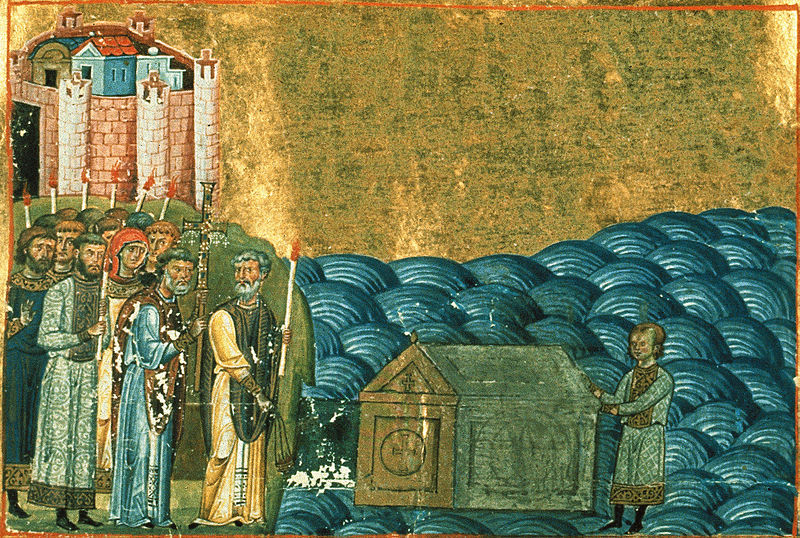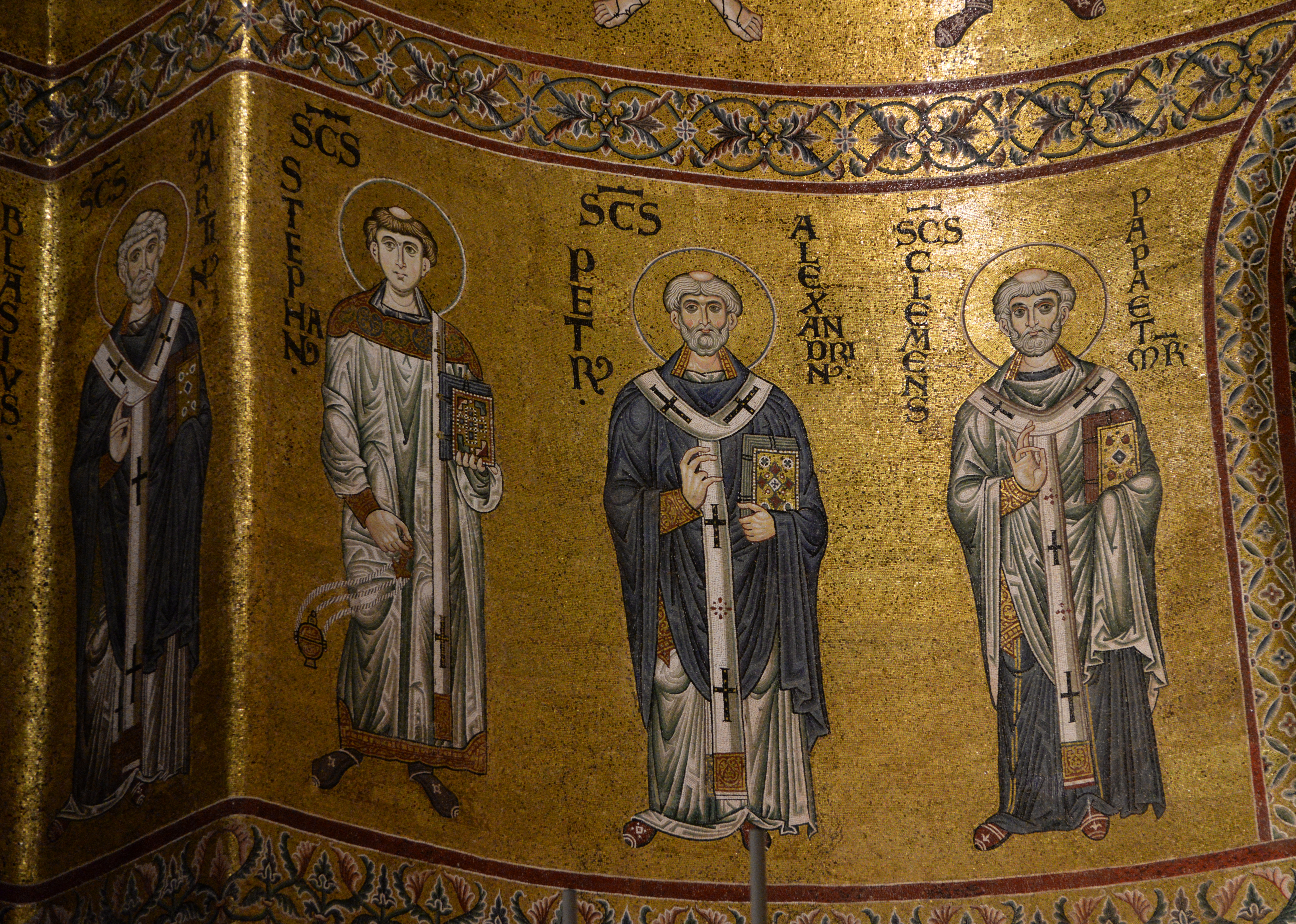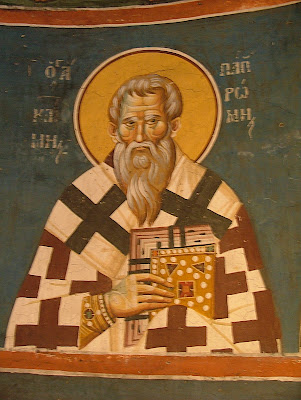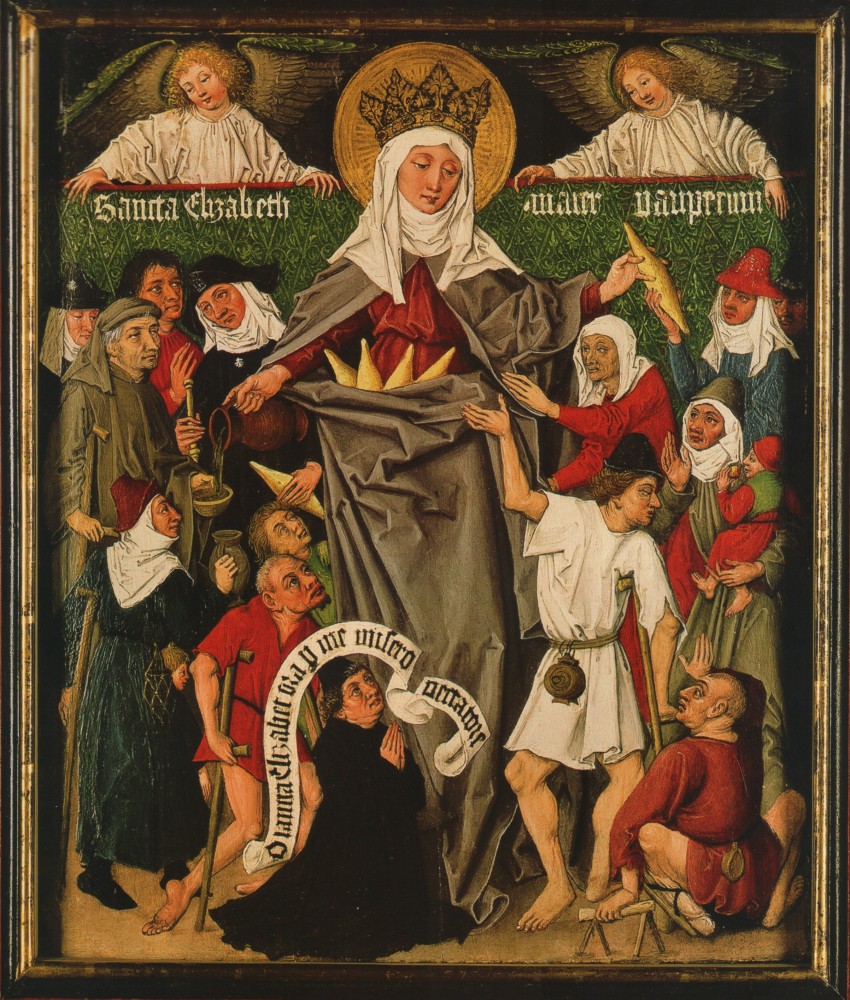John Dillon has posted on the Medieval Religion discussion group a selection of images of Pope St Clement I, whose feast is today.
As a saint he was popular in Denmark, and hence dedications to him in the Danelaw and, most famously, St Clement Danes in London. St Clement's in Oxford was presumably the area settled by the Danes before, and perhaps after the St Brice's day massacre here. In my home town of Pontefract the collegiate chapel in the castle is also a probable legacy of Danish settlement - the archaeologists working on the site twenty five or so years ago thought it was situated on the highest natural part of the castle rock, and pre-dated the Norman castle
John Dillon writes as follows:
The author of an extant letter to the church of Corinth and the suppositious author of the pseudo-Clementine
Recognitions and
Homilies, Pope St. Clement I (d. c. 100) occupies either third or fourth place in early lists of the bishops of Rome. Although it now seems unlikely that he was martyred, throughout the Middle Ages he was accorded martyrial status (as he still is in many churches). According to his legendary late antique Passio (BHL 1848; translated into Greek, BHG 349-350), Clement was exiled by the Emperor Trajan to the mines of Crimea, evangelized there with much success (in which effort he was aided by his miraculous discovery of an underground stream from which his parched fellow workers then drank), and for his pains was thrown into the Black Sea weighted down with an anchor. In response to the prayers of his disciples Cornelius and Phoebus, the waters parted and Clement's body was miraculously revealed in a chapel where the faithful could venerate him annually for a week beginning on his _dies natalis_.
Thus far Clement's Passio. In the ninth century, Sts. Constantine / Cyril and Methodius brought to Rome from Constantinople bodily relics believed to be his. These were placed in Rome's basilica di San Clemente. Constantine / Cyril is said to have found or obtained them, together with the fatal anchor, in the Crimea. Here's a view of Constantine / Cyril and Methodius receiving Clement's remains by the Black Sea as depicted in the late tenth- or very early eleventh-century so-called Menologion of Basil II (Città del Vaticano, BAV, cod. Vat. gr. 1613, p. 204):
In an eleventh- or early twelfth-century fresco painted in what is now the lower church of San Clemente and depicting its reception of that saint's relics, Constantine/Cyril and Methodius (one nimbed, the other not) are shown at left accompanying the Pope:
Another view, taken from a watercolour of the fresco made shortly after its discovery in the nineteenth century:
A dubious tradition known to the author of the first Vita of St. Genovefa of Paris (BHL 3334; ca. 520) and perpetuated in, e.g., the legendary Passiones of St. Dionysius / Denys of Paris claims an apostolic origin for the church of Paris and for other Gallic churches through evangelization by missionaries whom Clement had sent out from Rome. Modern historical scholarship commonly rejects this notion.
In the (pseudo-)Hieronymian Martyrology and in the ninth-century martyrologies of St. Ado of Vienne and Usuard of Saint-Germain Clement's
dies natalis is given as VIIII Kal. Dec. (23. November). This remained Clement's feast day in the medieval Latin West and is still his feast day in churches whose sanctoral calendars descend from medieval Latin-rite Uses. In the medieval Greek church Clement's feast falls on 25. November in pre-Metaphrastic menologia, in the later tenth-century Metaphrastic Menologion, and in the initially tenth- and eleventh-century Synaxary of Constantinople. This remains his feast day in churches employing the Byzantine Rite.
By way of supplement to Gordon Plumb's recent post (23. Nov.) of links to medieval images of pope St. Clement I in glass, herewith links to some other period-pertinent images of this saint in various media:
a) as depicted (second from left, after St. Martin of Tours) in the heavily restored later sixth-century mosaic procession of male saints (c. 560) in the nave of Ravenna's basilica di Sant' Apollinare Nuovo:
Detail view (courtesy of Genevra Kornbluth):
http://www.kornbluthphoto.com/images/ApNSouth10.jpg
b) as depicted (second from left, after Pope St. Sylvester I) in a later eighth-century fresco ( between 757 and 767) in the nave of Rome's chiesa di Santa Maria Antiqua:
c) as depicted (left margin at bottom) in a ninth-century copy of St. John Damascene's
Parallela sacra (Paris, BnF, ms. Grec 923, fol. 309v):
http://gallica.bnf.fr/ark:/12148/btv1b525013124/f622.item.zoom
d) as depicted (at centre, saying Mass) in an eleventh-century fresco in what is now the lower church of Rome's basilica di San Clemente:
e) as depicted in a mid-eleventh-century mosaic in the cathedral of St. Sophia in Kyiv / Kiev (lower portion restored with oil painting in the nineteenth century):
f) as portrayed in relief (upper register at centre) on the tympanum (c. 1151-1175) above the west portal of the chiesa abbaziale di San Clemente a Casauria in Castiglione a Casauria (PE) in Abruzzo:
g) as depicted (at far right, after Sts. Martin of Tours, Stephen protomartyr, and Peter of Alexandria) in the late twelfth-century apse mosaics (c. 1182) in Monreale's basilica cattedrale di Santa Maria Nuova:
h) as depicted (at left, receiving the volume from its author-compiler) at the end of brother John Berard's late twelfth-century cartulary chronicle of the abbey of San Clemente a Casauria (1182; Paris, BnF, ms. Latin 5411, fol. 272v):
http://gallica.bnf.fr/ark:/12148/btv1b84526553/f556.item.zoom
i) as depicted (upper register at right; at left, St. Peter) in the very late twelfth- or very early thirteenth-century apse mosaic (c. 1200) of Rome's basilica di San Clemente:
j) as depicted in a thirteenth-century fresco in the rupestrian church of the grotta di San Giovanni at Cafaro, a locality of San Vito dei Normanni (BR) in southern Apulia:
k) as depicted (twice: at left, being baptized by St. Peter; at right, saying Mass) in a panel of the thirteenth-century St. Clement window in the choir of Köln's Basilika St. Kunibert (an earlier to mid-thirteenth-century replacement for a predecessor dedicated to Clement):
http://media.kunst-fuer-alle.de/img/41/g/41_00448697.jpg
Detail views:
l) as depicted (lower register at right; sending St. Dionysius and companions to Gaul) in a mid-thirteenth-century copy of a French-language Life of St. Dionysius of Paris (Paris, BnF, ms. Nouvelle acquisition française 1098, fol. 34r):
http://tinyurl.com/25year8
m) as depicted (upper register) in a panel of a mid-thirteenth-century glass window (c. 1245-1250; w. 201) in Strasbourg's cathédrale Notre-Dame:
http://therosewindow.com/pilot/Strasbourg/w201d-whole.htm
n) as depicted (martyrdom) in a late thirteenth-century copy of French origin of the _Legenda aurea_ (San Marino, CA, Huntington Library, ms. HM 3027, fol. 162v):
http://digitalassets.lib.berkeley.edu/ds/huntington/images//000918A.jpg
o) as depicted in the late thirteenth-century frescoes (c. 1295) by Michael Astrapas and Eutychios in the church of the Peribleptos (now Sv. Kliment Ohridski) in Ohrid:
p) as depicted (martyrdom) in a fourteenth-century glass window panel of French origin in the Burrell Collection, Glasgow:
q) as depicted (martyrdom) in an early fourteenth-century collection of French-language saint's lives (St John's College, Cambridge, MS B.9, fol. 133v):
http://tinyurl.com/2hendw
r) as depicted (at left; at right, St. Astius of Durrës / Durazzo) in the earlier fourteenth-century frescoes (c. 1308-1320) by Michael Astrapas and Eutychios in the church of St. Nicetas the Goth (Sv. Nikita) at Čučer in today's Čučer-Sandevo in the Former Yugoslav Republic of Macedonia:
http://tinyurl.com/ok8rar5
s) as depicted (at the foot of the page; martyrdom) in the early fourteenth-century Queen Mary Psalter (c. 1310-1320; London, BL, Royal MS 2 B VII, fol. 279r):
http://www.bl.uk/manuscripts/Viewer.aspx?ref=royal_ms_2_b_vii_f279r
t) as depicted (at left; at right, St. Meletius of Antioch) in the earlier fourteenth-century frescoes (ca. 1312-1321/1322) of the Paraclis of the Theotokos in the monastery church of the Theotokos at Gračanica in, depending on one's view of the matter, Serbia's province of Kosovo and Metohija or the Republic of Kosovo:
http://tinyurl.com/yekmrox
Detail view (Clement):
u) as depicted (at left, with St. Hippolytus, Bishop of Pontus and St. Metrophanes [of Byzantium]) in the earlier fourteenth-century frescoes (c. 1313-1318; conservation work in 1968) by Michael Astrapas and Eutychios in the church of St. George at Staro Nagoričane in the Former Yugoslav Republic of Macedonia:
http://tinyurl.com/3zpcevk
v) as depicted (at left in panel at upper left; at right, the martyrdom of St. Peter of Alexandria) in an earlier fourteenth-century pictorial menologion from Thessaloniki (betw. 1322 and 1340; Oxford, Bodleian Library, MS Gr. th. f. 1, fol. 18v):
http://image.ox.ac.uk/images/bodleian/msgrthf1/18v.jpg
w) as depicted (second from right, sending St. Dionysius and other missionaries to Gaul) in an earlier fourteenth-century copy of the
Legenda aurea in its French-language version by Jean de Vignay (ca. 1326-1350; Paris, BnF, ms. Français 185, fol. 204v):
http://tinyurl.com/yfrz7hr
x) as depicted (martyrdom) in an earlier fourteenth-century French-language legendary of Parisian origin with illuminations attributed to the Fauvel Master (ca. 1327; Paris, BnF, ms. Français 183, fol. 74r):
http://tinyurl.com/ylal2j2
y) as depicted (at left; at right, the martyrdom of St. Peter of Alexandria) in the earlier fourteenth-century frescoes (ca. 1335-1350) in the narthex of the church of the Holy Ascension at the Visoki Dečani monastery near Peć in, depending on one's view of the matter, either the Republic of Kosovo or Serbia's province of Kosovo and Metohija:
z) as depicted (martyrdom) in a mid-fourteenth-century copy, from the workshop of Richard and Jeanne de Montbaston, of the
Legenda aurea in its French-language version by Jean de Vignay (1348; Paris, BnF, ms. Français 241, fol. 311r):
http://tinyurl.com/28sckhc
aa) as depicted in a cutting from a later fourteenth-century gradual (c. 1370) illuminated by Silvestro dei Gherarducci for the monastery of Santa Maria degli Angeli in Florence (Florence, Biblioteca Laurenziana, Cod. cor. 2; this image from fol. 159r):
bb) as depicted (twice: at left, uncovering the buried stream; at right, martyrdom) in a later fourteenth-century copy of books 11-13 of Vincent of Beauvais'
Speculum historiale in its French-language version by Jean de Vignay (ca. 1370-1380; Paris, BnF, ms. Nouvelle acquisition française 15941, fol. 16v):
http://gallica.bnf.fr/ark:/12148/btv1b8449688c/f40.item.zoom
cc) as depicted in a fifteenth-century glass window panel of German origin in the Burrell Collection, Glasgow:
https://www.flickr.com/photos/paullew/8209861563
dd) as portrayed in a fifteenth-century polychromed wooden statue on the high altar of the Sankt Clemens Kirke in Rømø (Tønder Kommune), Syddanmark:
ee) as depicted (at right; baptizing St. Taurinus) in a panel of a mid-fifteenth-century glass window (c. 1450) in Évreux's église Saint-Taurin:
ff) as depicted in grisaille (martyrdom) by Jean le Tavernier in the mid-fifteenth-century Hours of Philip of Burgundy (ca. 1451-1460; Den Haag, KB, ms. 76 F 2, fol. 257r):
http://manuscripts.kb.nl/zoom/BYVANCKB%3Amimi_76f2%3A257r_min
gg) as depicted by Giovanni di Paolo in a mid-fifteenth-century panel painting (c. 1455; from a dismembered altarpiece) in the Musée du Petit Palais, Avignon:
hh) as depicted (lancet at far right; at left and centre, the martyrdom of St. Thomas of Canterbury) in a later fifteenth-century glass window (w. 214) in Paris' église Saint-Séverin:
http://www.flickriver.com/photos/29495960@N00/15021005293/
ii) as depicted (lower register at left; blessing St. Domitilla in prison) in an illumination depicting events from the legendary Passio of Nereus and Achilleus in a later fifteenth-century copy of Vincent of Beauvais'
Speculum historiale in its French-language version by Jean de Vignay (1463; Paris, BnF, ms. Français 50, fol. 358v):
jj) as depicted by Peter Hemmel of Andlau in a panel of a later fifteenth-century glass window (1477-1478) in Ravensburg's Liebfrauenkirche:
kk) as depicted (upper register at far left) by Domenico Ghirlandaio in a later fifteenth-century panel painting (c. 1479) of the Madonna and Christ Child with Saints in Lucca's cattedrale di San Martino:
ll) as depicted (uncovering the buried stream) in a later fifteenth-century copy of Vincent of Beauvais'
Speculum historiale in its French-language version by Jean de Vignay (c. 1480-1490; Paris, BnF, ms. Français 245, fol. 182v):
http://tinyurl.com/qjp32yd
mm) as depicted (right margin at top) in a hand-coloured woodcut in the Beloit College copy of Hartmann Schedel's late fifteenth-century
Weltchronik (
Nuremberg Chronicle_; 1493) at fol. CVIIIv:
http://www.beloit.edu/nuremberg/book/6th_age/left_page/12%20%28Folio%20CVIIIv%29.pdf
nn) as depicted by Bernardino Fungai in two late fifteenth- or early sixteenth-century predella panel paintings (c. 1498-1501; from his Coronation of the Virgin altarpiece in Siena's chiesa di Santa Maria dei Servi) in the York Art Gallery, York:
1) Uncovering the buried stream:
2) Martyrdom:
oo) as depicted in a late fifteenth-or early sixteenth-century vault fresco (c. 1500-1503; restored, 1896-1899) in Skivholme Kirke (Skanderborg Kommune), Midtjylland:
pp) as depicted (at right; at left, St. Christopher) in an early sixteenth-century fresco (c. 1515-1520) in Aarhus Domkirke (dedicated to Clement):



